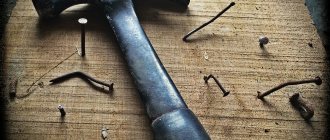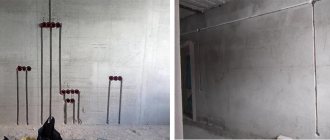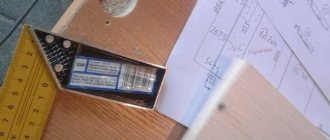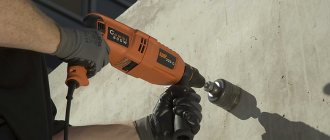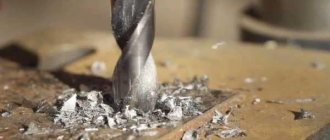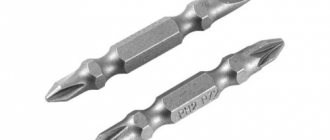Is it possible to drill concrete with a screwdriver - 4 popular tool models
To perform minor repairs at home, you need to have a suitable tool - a drill-driver. The name itself speaks about the direct purpose of the device - for screwing and unscrewing with special equipment - a “bat”. It is also suitable for drilling holes in materials, for example, if the power tool is equipped with a hammer function, then you can drill into concrete, stone or a brick wall.
- Is it possible to drill concrete with a screwdriver?
- Design features and characteristics
- Advantages of impact drilling machines for concrete
- Manufacturers of hand tools: TOP 4 popular devices
- DeWalt DCD985M2
- Makita BHP 452 RFE
- BOSCH Uneo
- Metabo PowerMaxx SB
- How to use the tool?
Is it possible to drill concrete with a screwdriver?
To answer this question, you need to know in what material you need to drill holes, what depth and diameter. Holes with a diameter of 10 mm or more are problematic to make using a screwdriver. But if the drill is thin (3-5 mm), then you can drill with such elements using a screwdriver. The rotation speed of the drill affects the ability to drill into hard materials. For screwing, a value of 500 rpm is suitable, and concrete can be drilled with a tool with a head rotation speed of 1300-1500 rpm. Equally important is torque, namely, how much force is applied to tighten the screws or drilling process. For concrete, choose a screwdriver with a power of 140 N/m, using it in the working extreme position of the coupling at maximum power.
Mixer - mixing construction mixtures
This mixer is definitely not for pancakes. Although, if you knead the dough in buckets, then a drill will do. But in general, a mixer attachment is needed for uniform mixing of building mixtures. They are suitable for dense, liquid or fluid masses.
It is better not to use screwdrivers at all for mixing dense masses, and drills - only for small volumes, being careful not to overload the engine. Different models of mixers differ from each other:
- load capacity - from 10 to 65 kg;
- length - from 400 to 600 mm;
- shank type - hexagonal, threaded and SDS.
When choosing, it is advisable to take into account the degree of corrosion protection, since you will be working with mixtures containing water.
A screwdriver that can drill concrete: myth or reality
Many manufacturers indicate in the characteristics of screwdrivers that the tool can drill holes in concrete with a diameter of up to 13 - 16 mm. Therefore, it is tempting to buy a screwdriver and use it instead of a drill. But how realistic is this, and will the device “die” after the first hole in a concrete wall? We decided to figure out whether a screwdriver can drill concrete, and what is needed for this.
Origin of screwdrivers
Each tool is created to solve a specific range of problems. Therefore, it is worth starting to consider this issue with a brief excursion into history. It begins with the appearance in Ancient Rome of hand drills, which were driven by rotating the handle. Much later, only in the 19th century, electric drills were created, which increased the drilling speed tens of times due to the higher rotation speed of the electric motor compared to manual rotation of the rotor or crank.
Further evolution developed by “crossing” electric drills with other types of tools. We “cross” a drill with a jackhammer by including an impact mechanism in its design - we get a hammer drill. We change the gear ratio in order to reduce the speed and not tear off the heads or spoil the slots of screws and self-tapping screws - we get a screwdriver.
| The evolution of the tool from the hand drill to the modern variety of devices. |
Why is a screwdriver bad at drilling concrete?
An ordinary electric screwdriver, although it is a type of drill, is structurally “tailored” for other tasks. The key difference is the reduced chuck rotation speed. The operating speed of simple single-speed screwdrivers, which are used in construction and manufacturing, usually does not exceed 750 rpm (compare this figure with the characteristics of electric drills, which have a chuck rotation speed of at least 2500 rpm). This speed is only sufficient for drilling brick (ceramic brick is usually drilled in modes from 400 - 600 rpm), but not enough for drilling concrete (the optimal rotation speed of inexpensive drills for concrete with a diameter of 10 - 13 mm lies in the range from 900 rpm to 1100 rpm).
But more importantly, a conventional single-speed screwdriver does not have an impact mechanism. Therefore, it cannot effectively crumble concrete or brick at the point of contact of the drill with the material. In addition, the design of the gearbox, bearing assembly and limit coupling does not imply significant axial loads. Therefore, using a conventional screwdriver, it is possible to drill concrete only theoretically, but in practice, attempts to drill dense structural materials usually end in lengthy and fruitless picking, as well as accelerated wear of the tool.
Drills/drivers and concrete drilling
Fortunately, the “evolution tree” of hand-held power tools has a “side branch” in the form of drills and screwdrivers, which are represented by a large assortment of corded and cordless models. They are the ones who can (with some reservations and stretches) drill concrete.
To confidently and quickly drill concrete using a drill-driver, you need:
- sufficient power - to drill durable structural materials you need a tool with a power of 750 W or more;
- impact mode - the function of axial impact, combined with rotation of the cartridge, allows you to effectively destroy concrete at the point of contact;
- powerful battery - a cordless tool must be equipped with a battery with high current output in order to confidently rotate the drill in thick concrete;
- correct equipment - for drilling concrete walls and ceilings, you need special concrete drills with carbide tips or diamond coating.
| Special drills for concrete: DeWALT, Bosch and Hilti. |
The difference between the impact mechanisms of a screwdriver and a hammer drill
It’s worth dwelling separately on the shock mode. The design of the impact mechanism of a drill-driver is fundamentally different from the design of a similar hammer drill unit. There is no crank mechanism or “drunk” bearing inside the screwdriver, which would allow developing the high impact energy necessary for chiseling concrete. This function is implemented differently: the axial movement of the cartridge is created using two wavy washers (ratchets). When the engine rotates, the cartridge washer “jumps” along the protrusions of the stationary washer. A drill moves behind it, making reciprocating movements and crumbling the concrete a little at a time.
Design and characteristics
Externally, as well as in mechanical action, a screwdriver resembles a drill. The difference is the low rotation speed/high scrolling torque. In addition, screwdrivers have fixed speed settings (on drills they are self-adjustable). Control over speed is necessary for safe and high-quality operation of the tool. The chuck stops moving the moment the screw is fully tightened. Even though the chuck has stopped, the motor is still running.
A specific speed/mode of operation is designed for a particular type of work. There is a function for reverse, tightening, unscrewing screws (as well as nuts, screws, self-tapping screws, soft materials). Craftsmen use screwdrivers all the time. In some cases (working with drywall, assembling an interior, creating a partition), the tool increases the speed and productivity of work several times.
Diagram of a cordless screwdriver.
Screwdrivers are designed on the same principle. Design basis:
- pistol-shaped handle (for working with the leading hand);
- little weight;
- a start key that starts/controls rotations;
- power source - mains or battery (note that the battery is more massive and more expensive than the tool itself);
- capacity is limited by the total weight of the tool;
- continuous operation time - about 3 hours;
- Spare battery available (depending on model).
HOW TO DRILL A HOLE IN CONCRETE?
Holes in concrete are necessary for conducting and installing communications. The work is characterized by an abundance of dust, noise, high labor costs, and requires high-quality power tools. To drill a hole in this material, Honor follows that every hole in the building’s load-bearing frame reduces its strength, is fraught with damage to the engineering systems located inside (mainly electrical wiring, ventilation ducts), and is dangerous.
Through holes with low quality tools cause adjacent sections of walls to crumble at the exit of the drill/bit from their reverse side. Additional finishing is required, the work time increases.
Video: Can You Drill a Wall with a Screwdriver?
Use Cases
Proper use of a screwdriver. is its use in accordance with instructions or established documentation. According to these documents, the main application is the direct ability to screw and unscrew various fasteners, as well as for drilling various holes.
Depending on the capabilities, one or another model can be used both in everyday life and in the professional sphere. Household screwdrivers are cheaper and have less power, while professional models have increased power, high performance and wider functionality.
But some users use a screwdriver for such unusual things as polishing a car, mixing mixtures or paints, sanding various surfaces, twisting wires, knitting fittings, and even drilling holes in ice.
Twisting wires
A screwdriver with a special tip is ideal for twisting removable wire ends. Twisting is usually done with pliers, but anyone can use a screwdriver using it for this purpose. The main thing is to perform this tricky procedure correctly.
Reinforcing knitting
You can use a screwdriver with steel wire to tie the fittings together. This is widespread during construction, when various reinforced concrete structures of buildings and foundations are erected. For knitting, use a cordless or corded crochet tool.
Features of drilling concrete
As mentioned above, a screwdriver can be used in different areas and in different ways. Using electric screwdrivers, you can drill into wood, concrete, and many other materials. Carefully read the instructions for using a particular model, because it tells you what materials it can be used for.
Tools
To drill a reinforced concrete surface, you need to use specialized tools - in our version, you won’t be able to get by with a homemade tool.
Based on your preference for the diameter of the hole, you can use a hammer drill, also called a small-sized electric hammer drill. What is the best way to drill a concrete wall in an apartment or panel house: a regular screwdriver with a drill, is it possible to make a hole in a concrete wall with a dust-free hammer drill, and how. Is it possible to drill with a screwdriver? “Is it possible. The first option has less power, but has less weight and an inconvenient design. The hammer drill, accordingly, has greater potential, weight and dimensions.
Read also: Float switch for pumping station
Be careful! Since the use of construction equipment is often one-time in nature, it is more rational to rent them. Considering that their price is quite high, this way you will save a considerable amount of money.
In addition to the existing tools, it is necessary to purchase special drill bits that allow you to work with a concrete surface. For a hammer drill, drills with a Pobedit tip are selected.
A hammer drill has its own weight characteristics and a set of impact attachments, which, in most cases, are quite enough . Drills with a tip are also used as additional components for the hammer drill.
To form holes with a diameter of thirty-five to one hundred and twenty mm, crown bits are used, which have pobedite teeth - using them, grooves for sockets, switches, etc. are drilled. If you are deciding on the question of how to drill concrete with a screwdriver, then there are also tungsten carbide-coated crowns for this. However, please note that they are only suitable for units with a power of two or more than 1kW.
Expert advice
In order for you to correctly drill a concrete wall, you must have the necessary equipment, perform all work carefully and adhere to the following recommendations:
- without a hammer drill, the work can be done with an impact drill or drilled with a screwdriver ;
- do not buy cheap drills, as their pobedite tip falls off very quickly and they fail;
- instead of a punch, you can use a pobedit tool, with one you will break the crushed stone, and with the second, inserted into a regular electric drill, you will drill;
- to work with concrete, the hammer drill must have an SDS-plus chuck;
- take into account the placement of the reinforcement to determine where it is located, you can use a metal detector; if the reinforcement is exposed, it must be painted to prevent rusting;
- To work with concrete, you can use universal diamond-coated drills, but you need to insert them only into a regular drill, or you need to turn off the impact mode.
A regular drill or screwdriver
If you do not have the tools described above, then this work can be done using a conventional electric drill or a powerful screwdriver.
Drilling will take more time than using a hammer drill, but you can do it yourself.
How to drill concrete and brick with a screwdriver
In this case, in addition to a drill and a drill bit, you will also need a punch. First, a small depression is made at the drilling site using a punch and a hammer.
After this, they insert the working tool into it and begin to drill. If the drill stops, break the hard areas again with a punch and continue working.
Drilling
The process of drilling concrete is not particularly complicated and consists only of the ability to work with the tool. When working with drills, you should combine the hammer mode with drilling.
Before drilling reinforcement in concrete, you need to change the tip for working with concrete to a regular metal drill and drill through the obstacle. It is important to remember to turn off the bumper mode before drilling into the concrete.
In addition to the above, there are also a number of useful tips that will help you achieve quality results.
Peculiarities
Concrete structures are highly durable, so drilling them yourself is quite difficult.
This is due to the fact that crushed stone is used to create concrete products, and when you come across it while drilling, the process becomes very difficult.
The need to drill a concrete wall arises quite often; this is necessary for installing shelves, cabinets, air conditioning, gluing wallpaper, attaching a lamp, when attaching insulation, or when plastering walls to attach beacons.
Special devices
In specialized stores you can find for sale special annular drills with diamond coating at the end. They are used for drilling rigs, which are used to drill fairly large holes, the diameter of which can even reach twenty-five centimeters. I would like to point out right away that such devices are very expensive, so purchasing them for drilling walls at home is absolutely pointless.
In cases where during repair work the wall must be supplemented with an socket or switch, another variation of the tool is used. This is a crown that has metal soldering along the entire circumference of its cutting edge. The diameter of the crowns varies from thirty to one hundred and twenty millimeters, but the standard size is sixty-eight millimeters.
The fact is that a hole of this size needs to be drilled in the wall to install a switch or socket. If you continue to wonder about how to drill through concrete when using a crown, I will answer that a hammer drill that has its impact mode disabled is ideal for this mission. If the wall being treated is too thick, you can use special extension attachments.
The crown itself can act as an attachment, but for a drill. This type does not have soldering, but is covered over the entire area with a coating consisting of a tungsten carbide alloy. An additional advantage of this attachment is that there is no need to change tools in cases where it is necessary to drill a wall lined with ceramic tiles. The thing is that such a nozzle fits perfectly on both tiles and concrete.
I want to note that this type of charging can only be used on those impact drill models with a power of at least a thousand watts.
Often, the work of a hammer drill is accompanied by the use of drills, the diameter of which can vary from four to eighty millimeters. Many modern craftsmen are faced with the question of how to choose the correct drill diameter.
You can avoid this situation without much difficulty, because in order not to think about how to drill concrete later, you can immediately purchase a set of special drills when purchasing a hammer drill. Naturally, really high-quality kits that allow you to easily drill concrete walls are quite expensive, so I advise you to purchase a drill as needed in accordance with the diameter of the dowels used.
The most suitable way
You must decide what is best for drilling into concrete walls. Often a conventional drill is used. It is convenient if it is two-handed, which will facilitate the process, because the master will need to put in a lot of effort.
If large-scale work is planned in the apartment, then you can drill the wall using a hammer drill. To make holes of impressive diameter, it is worth taking a motor drill. Its power should start from 5 kW. There are no such household models, so such a device cannot be powered using a single-phase network.
Hammer
The efficiency of this tool is quite high due to the chiselling option, but this equipment is more expensive than an impact drill. When you are thinking about how to drill a concrete wall, it is recommended to consider a hammer drill, which uses the principle of rotation and reciprocating movements of the working part, which speeds up the task. It is better not to drill cellular concrete this way, because it is completely destroyed under such influence due to its fragility.
When the surface of regular concrete has a plaster finish, care must be taken when making holes to ensure that the finish does not crumble. In order to drill holes in concrete, in addition to the tool, you need to use special drills with a diameter of 4 to 8 cm. In order to eliminate unnecessary expenses, you need to select the drill diameter according to the corresponding dowel parameter.
Household drill VS screwdriver
When thinking about the question of how to drill a concrete wall in an apartment, you can choose a drill. The result and safety of the equipment depend on how correctly the drill is chosen. Consumables with triangular tips are recommended. It is better if they are made of carbide metal. The drill may get stuck and no longer advance. In this case, you need to temporarily work with a punch.
When thinking about how to drill concrete with a screwdriver, you should take care not to damage the tool. The solution may be more powerful technology. But when suitable equipment is not available, you can try to carry out the work with the tool that is at hand. Additionally, a hammer and a punch are used.
The drill must be designed for working on metal. But you should be prepared for the fact that after such manipulations it will no longer be suitable. When you have to drill concrete without a hammer drill and only using a screwdriver, it is good if the equipment has an impact function. In addition to the model, you need to use equipment with a carbide working part for bricks.
Diamond drilling
The most effective way to drill holes in a concrete wall is by using diamond drilling. The peculiarity of this work is that you can even move at an angle. You can immediately begin installing socket boxes or other devices. Very little dust is generated. The main disadvantage of such drilling is the sometimes prohibitive price of equipment and the impressive cost of the work itself.
Work rules: tips
When working with tools, you must follow safety rules and general recommendations:
- 1) When performing work, protect your respiratory system, dust is harmful.
- 2) If you work outside, you need to install fences at 2.5 meters.
- 3) When performing work at a height of more than 1.5 meters, use a strong base - scaffolding or a goat.
- 4) When working with a tool, the speed must be turned on smoothly, and in no case should it be turned off when it is in the body of the wall.
- 5) When drilling through plaster, you must carefully study the communication plan so as not to hit anything.
- 6) It is strictly forbidden to drill through the decorative coating.
- 7) Choose the right drill bits for each surface.
 Wet the drill with water to prevent it from overheating.
Wet the drill with water to prevent it from overheating.
- Clothes and gloves must fit properly.
Under no circumstances should you try to hold the rotating chuck with your hand - this is what the drill body is for. Otherwise, you may injure yourself. If you use gloves, do not take them “with reserve”. Gloves that do not fit properly may also become caught in the chuck and cause injury. Overalls should not hang loose - they can be rolled up or pressed with sleeves.
- You should not press as hard as you can on the turned-on drill - this will cause you to fall, as it will become more difficult for you to control your balance. In addition, you may break the drill. If a tool passes through a concrete wall, the injuries it can cause to a person can be more than serious.
Return to contents
What will help the home handyman?
At home, when you need to make 2-3 holes in concrete, you can get by with a regular drill, without the impact function. the concrete from time to time with a strong metal pin (punch) matching in size to the diameter of the hole. It is used when the drill begins to “stick” in the wall. At this moment, a steel punch is inserted into the hole and they begin to hit it with a hammer or sledgehammer, trying to crush areas that are too dense and punch the hole deeper. In this case, the pin is turned a little. Then the hammerless drill can start working again.
All the above steps are repeated one after another until the hole increases to the required depth. This method is quite labor-intensive and tedious, but for a couple of holes it is quite acceptable.
Alternatively, when drilling a hole in concrete, you can use universal diamond-coated drills. They are highly effective when working with metal, crushed stone and concrete. They can only be installed on a conventional electric drill, or on a tool with the vibration function disabled.
You need to work with the drill extremely carefully, otherwise it will fail too quickly. The advice that professionals give is that to avoid overheating of the drill, it should be moistened with cold water from time to time.

